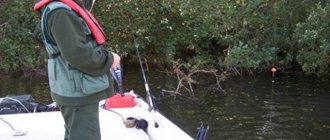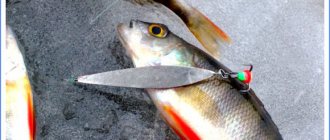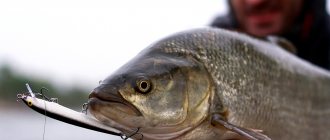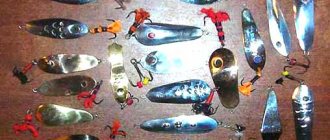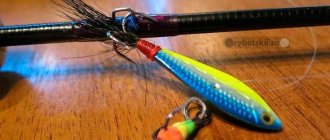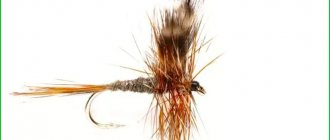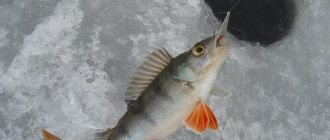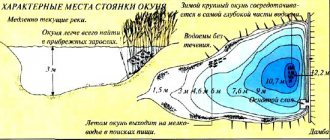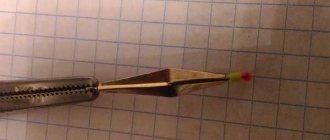What to consider when choosing
Winter perch lures are similar to their counterparts used for catching pike perch and pike perch. At the same time, they have some features in the structure and nature of the game.
Main characteristics
Perch spoons have the following characteristics:
- Size (length) – perch is caught with baits ranging from 15-20 to 60 mm in length. At the same time, spinners up to 20-30 mm in size are used when fishing at depths of up to 3 meters. 40-50 mm baits are well suited for fishing at medium depths (up to 6 meters). The largest, 60-millimeter spoons are used for deep fishing in 8-10-meter holes and pools.
- Shape – perch is well caught on narrow, teardrop-shaped, diamond-shaped spinners;
- Weight – perch baits, depending on length, material, shape, weigh from 3-3.5 to 15-16 grams. The lightest models are used for fishing in the coastal zone with depths of up to 3 meters. The heaviest models are suitable for fishing in current conditions, depths of more than 5-6 meters.
- Hook type and fastening - triple, double and single hooks are used on winter perch lures. Hooks can be rigidly soldered to the petal of the spoon, or have a movable fastening using a winding ring or a thin metal chain. Models with a rigid hook fastening have a more stable game and are used for catching active fish. Quite catchy winter lures for perch, with movable hooks (on a winding ring, chain) are used for capricious, changeable bite, low predator activity in the middle of nowhere.
- Material – homemade and factory-made perch spinners are made from sheet copper, brass, and stainless steel. Some models of such baits are also made from darker and more viscous bronze.
- Coloring - perch is caught on spinners with both single-color (silver, gold, copper, nickel) and two-color petals (gold/silver, gold/nickel). Also, spinners that have a striped, bright (fluorescent) color are often used. To increase attractiveness, I often string red beads, woolen thread, and cambrics onto the hooks of spinners.
Recommended reading: How to catch trout with a spinning rod at different times of the year
Types by design
Lures may differ in the location of the center of gravity, as well as in their behavior when retrieved. Lures for perch for winter fishing come in 4 main types:
- Vertical (bottom) - have a lower center of gravity, due to which they have a strictly vertical game without significant deviations. During landing, they raise turbidity, which additionally attracts a predator.
- Gliding - have a strongly concave petal shape, due to which, when playing, they deviate strongly to the side from the center of the hole, making oscillatory movements. Such baits are more suitable for vertical trolling.
- Loose – spinners with a center of gravity located in the middle of the bait’s body. This ensures that when lowered, the bait takes a horizontal position and makes high-frequency oscillatory movements (“crumbles”).
- “Step” are crescent-shaped baits with a single, hard-soldered hook. When playing, the bait does not sink to the bottom vertically, but by making stepwise leaps.
Important. You can check which of these species the purchased spoon belongs to in an aquarium or a bathtub filled to the brim.
This will help you choose the appropriate animation for the bait.
Techniques for catching perch with winter lures
In general, the methods of fishing for a striped predator are quite simple. The most difficult thing is to find the most promising place. At the very beginning, it is necessary to make at least 10 holes at a distance of 5-10 m towards the deepening of the reservoir.
Next you should fish the holes. At the same time, if there are no bites within 5 minutes, we go to the next hole.
Useful article, we recommend reading: How to quickly drill a hole using a screwdriver.
Technique for catching a striped predator:
- It is necessary to lower the spoon to the very bottom and lift it 3-5 cm up. In this case, the tip of the fishing rod should be at a height of 15-20 cm from the hole itself.
- We make a few twitches and, gradually accelerating, we rise higher, about 40 cm.
- We lower the rod and let the bait freely fall to its original depth. At this moment, the bait will make movements that are assumed by the shape of the spoon itself.
- We repeat the entire fishing process again.
If fishing does not bring the expected result, you can change the intensity and frequency of twitching of the bait. It all depends on many factors, and where some fishing methods do not work, you can resort to others. However, it all comes down to the following rules:
- At the beginning of winter and with the arrival of a thaw, perch is active and trolling should be carried out quite intensively.
- In the middle of winter and when there is severe frost, the activity of the striped predator noticeably decreases. Therefore, the spoon should imitate a sluggish and sedentary fish. Twitching of the bait should be replaced with smooth and slow retrieves.
It is important to know! If you manage to catch a school of perch near the bottom, and it is actively being caught, you can try to pull it closer to the surface. This will significantly speed up the process of catching a striped predator. To do this, make each “cast” 10-15 cm higher than the previous one. If at any point the bites stop, start again.
There are several ways to diversify the behavior of the spoon in the water column:
- We give the spoon the opportunity to sink to the very bottom. The tip of the rod must be right next to the hole. Next, you need to smoothly raise and lower the bait. The lifting height should be within 25-30 cm. It is necessary to make up to ten movements with pauses of several seconds between them.
- You can try to imitate a feeding fish that digs in the bottom mud. To achieve a similar effect, you need to lower the winter bait to the very bottom and, without lifting it up, try to move it, lifting the tail. After 10 seconds, we do a regular pull to the surface. This method of catching a striped predator can be carried out up to 20 times.
- Sometimes the perch does not stay at the very bottom, but in the middle or upper water column. To check its presence at all depths, you must initially lower the spoon to the very bottom, make several twitches and, at the end, make a big rise. With each new cast, we lower the spoon 15-20 cm higher than the previous time. If the bottom of the fished area is flat, you can try to slowly pull the bait along the edges of the hole.
Top 5 best factory models according to the editors
Among the factory-produced spinners for winter perch fishing, the following are most suitable:
- Nils Master Hanski is a lanceolate bait produced with a length of 35-70 mm and a weight of 3-16 grams. Equipped with a tee connected to the petal with a small chain. Depending on the intensity of the game, the bait can make both slow gliding and more active oscillating movements. Due to its shape it is suitable for fishing at depths of up to 10 meters.
- Nautilus (Puustjarven Viehe Ky) is a cone-shaped heavy bait with a flattened upper part, a single hook located on a chain. Produced in 4 sizes ranging from 40 to 80 mm in length and weighing up to 30 grams. Perch is caught using small baits.
- Favorit from Eco Pro is a Russian-made spinner in shape similar to the Finnish Nautilus. Unlike the Scandinavian model, the domestic one has smaller dimensions and weight (up to 65 mm and 15.5 grams, respectively). This makes it more suitable for catching perch at different depths.
- A series of winter spinners Salmo S (S1, S2, S3) are classic lures with a length of 31 to 55 mm and a weight of 1.5-6 grams. They have a drop-shaped petal, rigidly soldered or connected by a chain with single or triple hooks. They are used at depths from 2-3 to 7 meters.
- Captain Puustjärven is a famous winter lure with a diamond shape, 25-60 mm long and weighing 2-7 grams. It has a characteristic “yaw” game, in which it, falling to the bottom, makes spiral movements, moving far away from the center of the hole. Thanks to this feature, this model, like balance beams, attracts perch standing at a great distance from the hole. Used for catching perch at depths of up to 4 meters.
Recommended reading: Common ruff
You can purchase original baits described in this rating for an average of 200 - 600 rubles.
Selecting a location
The right fishing location in winter has a huge impact on its results. This is due to the constant change in fish behavior depending on time. With the beginning of winter, the activity of perch does not weaken; the fish can be found anywhere in the reservoir.
Holes should be drilled starting from the place closest to the shore where there is underwater vegetation, snags or stones. In these places, perch can wait for fry. As frost intensifies, the ice thickness increases and the fish move to depth. Perch at this time lives at a depth of 4–6 meters.
In winter, catching perch with a spoon is more effective if you catch it in the morning. The ambient temperature should not drop below 15 degrees. With the end of winter, perch requires increased nutrition before spawning, so you should look for it where fish fry accumulate.
Universal homemade products for all occasions
Among homemade winter spinners, the most popular are several models invented during the USSR.
Gvozdik
Classic vertical spinner. It consists of two copper plates, the space between which is filled with tin or lead and a movable double.
It has a stable and simple game with a slight lift (no more than 30 cm), and practically does not deviate from the center of the hole. Thanks to this feature, it is used for catching large and medium-sized perch in deep-sea drifts.
Step
A catchy and simple homemade model with a curved profile in the shape of a month and a rigidly soldered single hook.
The peculiarity of the “Steps” is that when dropping the bait it does not fall vertically, but is positioned first horizontally, then abruptly goes (“dives”) down. Such a spinner “works well” on sluggish and passive perch at medium and shallow depths.
A tube
The simplest and easiest to make winter perch spinner.
It is a brass or copper tube with a diameter of 10-12 mm with two non-parallel cuts at the ends (30 and 45), winding rings, and a movable double. It is used for catching perch at great (up to 10-12 meters) depths.
Torpedo
An elongated spinner with a slightly curved petal, one part of which has a layer of tin and lead soldered on it. With this bait, both rigidly soldered single and movable double hooks are used.
Coffin
A spinner is made of two plates - the upper one in the shape of a small coffin lid and the lower one, flat.
The space between the plates is filled with lead or tin. Equipped with a movable double. “Grobik” is used for fishing at various depths - from coastal irrigation to wintering pits and pools.
Voucher
An unusual type of winter spinner, which looks a little like a small wobbler.
The bait has a three-dimensional body, a ring, eyes and two hooks facing in different directions. Lures are made from lead or tin, painting the body like a fish or leaving it as is. The voucher attracts bass of all sizes. Color and quality of painting do not matter much.
The bait works better on active fish. Swings of the rod should not be very sharp, and throws should not be too high. Such aggressive behavior of the bait can alert the perch.
We recommend reading: Winter carp fishing: choosing gear and fishing tricks
Gliding decoys
Such spoons are flattened on both sides, which gives them the opportunity to play in the water column, attracting perches. They will come in handy for fisherman in shallow waters. Being lowered into the hole, the gliding spoon can be carried by the current away from the hole.
Thanks to this, the fishing area increases, and the fisherman can even catch fish that are located to the side of the hole.
Gliding spoons are good at times when the predator is actively feeding. Seeing an oscillating shiny bait, the perch most often immediately reacts to it.
Tackle elements
For winter trolling of perch, sensitive, reliable tackle is used - a winter 30-40-centimeter fishing rod with a reel.
The fishing line for a winter fishing rod is selected taking into account the weight and size of the bait. For the lightest spinners, monofilament with a cross-section of 0.12 mm is used, for medium ones - 0.12-0.14 mm. For large and heavy models, the strongest fishing line with a thickness of 0.15-0.17 mm is used. As a nod in such gear, pieces of bright nipple rubber and a twisted spiral monofilament with a cross section of 0.8-1.2 mm are used. A flat spring nod with a bright tip gives the perch fishing rod good sensitivity.
Leashes are not used in such gear - spinners are attached to the main fishing line using a movable loop.
Important. Leashes for winter tackle for vertical trolling of perch are needed in those reservoirs where there are a large number of pike. In this case, thin, short (10-12 cm long) tungsten or steel leashes with a small swivel are used.
In addition to the correct choice of bait and tackle, fishing tactics play a huge role in the winter lure of perch. The success of fishing directly depends on the distance traveled by the angler on the ice and the number of holes drilled per day. Winter fishing with a spoon is exciting and active. It will definitely appeal to people who don’t like to sit on one hole.
Homemade spinners
Factory-made spinners often have a high cost, and during fishing, due to frequent breaks, they turn into consumables for the fisherman. Therefore, many fishermen prefer to make their own baits. On the Internet you can often find drawings of winter lures for perch made from a tin can.
Such products are very simple, quite effective and you don’t mind losing them. To make a bait, you need to cut out a petal of a certain shape from tin, bend it on a wooden form and equip it with hooks inserted into rings.Sometimes properly made homemade products attract fish much better than expensive purchased models. Therefore, it wouldn’t hurt any fisherman to have several of these products in his arsenal. You won't need to spend a lot of time making them.
The most catchy lures for perch made in Russia
Top spinners from a domestic manufacturer:
- Aqua Shniaga. The main purpose of this bait is slow gliding at depth. The cost is 80 rubles.
- "Luck Pier No. 2." An inexpensive spinner that costs only 30 rubles. But despite its relative cheapness, it shows good results on various bodies of water.
- "Orlovskaya lure zander 07". A versatile bait with a ribbed surface for use in troubled waters. Due to its specific shape, the game of the spinner imitates the behavior of small fish. Also suitable for catching zander and pike. The approximate cost is 120 rubles.
- Russian Bait "Micro". An excellent spinner with a very complex and attractive game for predators due to the significantly lighter tail part of the bait. The product is also suitable for fishing in other fishing seasons. The price is 220 rubles.
- Eco Pro Favorit. You should choose this spoon only for reservoirs with calm water. It is characterized by sweeping movements when playing, which provokes even passive predators to attack. The cost is about 300 rubles.
Rating of the best models
To find the most catchy lure for winter fishing, it will be useful to evaluate the rating of the most popular models, which are well reviewed by experienced anglers. Fans of sheer trolling in winter prefer several inventions that consistently attract even a passive predator. In most cases, the list of the most effective baits includes home-made designs, since what is created by hand by hand is difficult to replicate in a factory setting.
Individual fishing brands, usually from Finland, supply the market with quality products that increase the chances of successful fishing even when there is no bite.
Among the most popular winter models are the following:
- "Rhombus".
- "Torpedo".
- "Karasik".
- "Half."
- "Malek."
- "Ray".
- "Sleeper".
- "Dovetail".
Winter spinners “Lindros” (hali lindroos luxus), “Lucky John” and “Rapal” products are also popular.
Each option has its own unique properties and can reproduce a unique game, forcing the lazy predator to become active. For best results, it is recommended to take several products with you when fishing at once in order to experiment with them and find what the fish really need. If you need to find a good pike perch model, then it will be useful to evaluate the top 10 best lures for pike perch.
